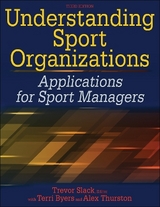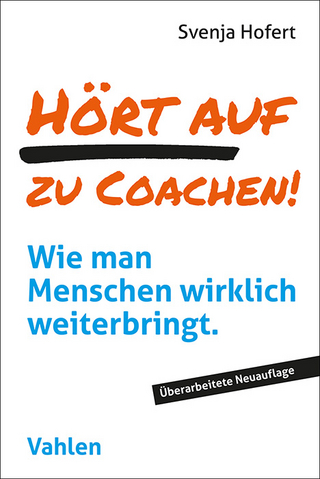
Understanding Sport Organizations
Human Kinetics (Verlag)
978-0-7360-5639-7 (ISBN)
- Titel erscheint in neuer Auflage
- Artikel merken
Understanding Sport Organizations: The Application of Organization Theory, Second Edition, a new edition of a ground-breaking text, continues to give readers a strong foundation in organization theory and application of that theory by providing a real-world context to all its issues. It engages readers by providing opportunities to discover the theory in practice through use of profiles, case studies, and examples of sport organizations in each chapter.
Updated with new research and current examples that will help the reader develop a clearer understanding of organization theory, this edition benefits the reader by featuring:
-A new chapter on strategic alliances explores the growing complexity of sport organizations and the impact that complexity has on the planning and decision making of sport managers. It will help current and future professionals recognize and understand the opportunities that exist both outside and within the sport industry to benefit their organizations.
-A new chapter on research in sport management prepares readers to become competent researchers by providing guidance on research design and methodology, data collection and analysis, and issues of quality.
-A new section in each chapter, titled “Key Issues for Managers,” details vital concepts that will help managers apply information taken from topics in the text to specific issues they face on the job.
To enhance understanding and bring the material to life, Understanding Sport Organizations: The Application of Organization Theory, Second Edition, references numerous current examples. Each chapter opens with a practical example of a sport organization and closes with a case for analysis that allows the reader to directly apply the information from the chapter. Throughout the text, “Time-Out” sidebars present examples to illustrate specific concepts under discussion. The examples are effective in highlighting for students and professionals the many different areas in which organization theory occurs.
The book also employs chapter objectives, summaries, key concepts, review questions, and suggestions for further reading for each chapter, guiding readers to a greater and more practical understanding of core issues. It also examines organizational goals, strategy, environments, culture, technology, power, conflict, leadership, change, and many other issues affecting sport managers.
This new edition provides readers with opportunities to discover sport organization theory in practical terms and to apply the knowledge in real-world situations. It engages readers in the many different areas in which organizational theory occurs; it also recognizes the dynamic, increasingly sophisticated sport industry, both in academic and applied settings. Understanding Sport Organizations: The Application of Organization Theory, Second Edition, is an invaluable resource for students and practitioners alike.
Trevor Slack, PhD, is Canada research chair of the International Institute for the Study of Sport Management at the University of Alberta in Edmonton, Alberta. Slack is widely published in major sport and organization journals and has presented as a keynote speaker at conferences on sport organizations around the world. He has been editor of the Journal of Sport Management and the European Journal of Sport Management, and he has been on the editorial board of several journals related to sport management. Slack has been awarded numerous grants for social science and humanities research projects. In 1995 he presented the Zeigler Lecture, the leading lecture in sport management, and in 2001 he was awarded a Canada Research Chair for his work in sport management. Milena M. Parent, PhD, is an assistant professor in the School of Human Kinetics at the University of Ottawa. Parent completed her PhD in the International Institute for the Study of Sport Management at the University of Alberta. She has experience as a national-level figure skater, a coach, and an administrator. Her doctoral research in sport management is on organizational theory and strategic management of large-scale sporting events. Parent is a coach for Skate Canada and a member of the Administrative Sciences Association of Canada, the Academy of Management, and the North American Society of Sport Management. She also serves as a reviewer for European Sport Management Quarterly and for the Administrative Sciences Association of Canada conference.
Foreword
Preface
Acknowledgments
Chapter 1. Organization Theory and the Management of Sport Organizations
-Why Sport Managers Need to Understand Organizations and Organization Theory
-Some Definitions
-Ways to Look at Sport Organizations
-State of the Art in Sport Management and Suggestions for Future Directions
-Format of the Book
-Format of Each Chapter
Chapter 2. Doing Research in Sport Management
-The Research Process
-Theoretical Framework
-The So-Called Qualitative–Quantitative Research Debate
-Research Design
-Data Collection Methods
-Data Analysis Methods
-Quality Issues
-The Write-Up
Chapter 3. Organizational Goals and Effectiveness
-Importance of Understanding Organizational Goals and Effectiveness for Sport Managers
-Organizational Goals
-Effectiveness or Efficiency
-Approaches to Studying Organizational Effectiveness
Chapter 4. Dimensions of Organizational Structure
-Complexity
-Formalization
-Centralization
Chapter 5. Design Options in Sport Organizations
-Typologies and Taxonomies
-Mintzberg's Configurations
-The Simple Structure
-The Machine Bureaucracy
-The Divisionalized Form
-The Professional Bureaucracy
-Adhocracy
-Organizational Designs As Ideal Types
-Notes on Organizational Size
Chapter 6. Strategy
-What Is Organizational Strategy?
-Levels of Strategy
-Strategy Formulation and Implementation
-Strategy and Structure
-Strategy in Voluntary Sport Organizations
Chapter 7. Strategic Alliances
-What Are Strategic Alliances?
-Establishing Strategic Alliances
-Managing Strategic Alliances
Chapter 8. Sport Organizations and Their Environments
-The Nature of the Organizational Environment
-Research on Organizational Environments
-Controlling Environmental Uncertainty
-Other Perspectives on the Organization–Environment Relationship
-The Relationship Between an Organization's Environment and Its Structure
Chapter 9. Sport Organizations and Technology
-What Is Technology?
-Research on Technology and Organizations
-Critiques of the Technology Imperative
-Microelectronic Technologies
-Relationship Between Technology and Organizational Structure
Chapter 10. Power and Politics in Sport Organizations
-Strategic Choice
-Power and Authority
-Sources of Power
-Organizational Politics
-Power in Sport Management Research
Chapter 11. Managing Organizational Conflict
-What Is Conflict?
-Horizontal and Vertical Conflict
-Is Conflict Dysfunctional to the Operation of a Sport Organization?
-The Conflict Process
-Sources of Conflict in Sport Organizations
-Conflict Management Strategies
-Stimulating Conflict
-Current Research About Conflict
Chapter 12. Organizational Change
-The Concept of Change
-Change As Paradox
-Perspectives on Organizational Change
-What Causes Organizational Change?
-Resistance to Change
-Dealing With Resistance and Implementing Change
-Stages of the Change Process
-Innovation in Sport Organizations
Chapter 13. Organizational Decision Making
-Defining Decision Making
-Conditions Under Which Decisions Are Made
-Approaches to Understanding Decision Making
Chapter 14. Managing Organizational Culture
-What Is Organizational Culture?
-Manifestations of a Sport Organization's Culture
-Thick and Thin Cultures
-One or More Cultures
-Organizational Culture and Effectiveness
-Creating, Managing, and Changing a Sport Organization's Culture
Chapter 15. Leadership and Sport Organizations
-Trait Approach
-Style or Behavioral Approach
-Contingency or Situational Approach
-Charismatic and Transformational Leadership
-The Critique of Leadership and Some Suggestions for Leadership
-Research in Sport Management
Bibliography
Index
About the Authors
| Erscheint lt. Verlag | 1.2.2006 |
|---|---|
| Zusatzinfo | 8.5 |
| Verlagsort | Champaign, IL |
| Sprache | englisch |
| Maße | 216 x 279 mm |
| Gewicht | 1225 g |
| Themenwelt | Sachbuch/Ratgeber ► Sport |
| Wirtschaft ► Betriebswirtschaft / Management ► Unternehmensführung / Management | |
| ISBN-10 | 0-7360-5639-4 / 0736056394 |
| ISBN-13 | 978-0-7360-5639-7 / 9780736056397 |
| Zustand | Neuware |
| Haben Sie eine Frage zum Produkt? |
aus dem Bereich



